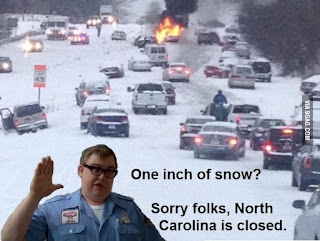Winter Driving Safety Tips
First of all, why are you out driving in the winter ice and snow to begin with?
It's understandable if you are a healthcare worker, emergency services personnel, police, rescue, fire fighter or even a lineman with the power company, we have to travel in treacherous conditions to take care of the sick, injured and other such problems. If you do not fall into one of those categories, you need to keep your tail at home. Nothing is so important that you need to risk your life or the life of your family to travel on snow/ice covered roads that you may not be used to traveling on. I live in the south, North Carolina to be exact, and nobody here can drive worth a darn when it snows (except the Northern transplants lol), southerners freak out and buy all of the bread and milk they can. They will still drive to the ER for a toothache and a work note.....come on. Please be safe and smart, Stop first and think about your decision to drive anywhere first. Only if you absolutely have to get in a car and drive, please follow these helpful tips to make your journey safer.
Driving in the snow
If you find yourself driving in the snow, stay alert, slow down and stay in control. These are the three key elements to safe driving in the snow.
Here are a few other tips for driving in the snow:
- If you think you may be heading into snow or there is a possibility of driving in the snow, make sure you do a maintenance check on your vehicle before making the trip. Check the vehicle battery, belts and hoses, anti-freeze, oil, lights, brakes, heater and defroster and check the exhaust system for leaks which may allow carbon monoxide to enter the vehicle.
- Plan your route ahead of time and give yourself extra travel time. Make sure someone knows your travel plans.
- Wear comfortable clothing that does not restrict your movement while at the wheel. Keep warm clothing available for when you exit the vehicle.
- Always clear any snow and ice from all windows, lights, mirrors and the roof before driving. After starting the vehicle wait for the interior windows to clear of fog so you will have appropriate visibility.
- Make sure there is sufficient windshield washer fluid in the vehicle reservoir and that it is rated for freezing temperatures.
- It takes longer to stop on slippery surfaces, so add additional time to the three-second rule.
- Know the proper handling procedures for a skidding vehicle.
- Slow down in snow and icy conditions, make turns slowly, and make all starts slow and smooth.
- Remember that bridges and overpasses may freeze before the regular travel lanes of a roadway. Watch out for black ice, areas of the roadway that appear black and shiny and where your vehicle can suddenly lose traction. Slow down in these areas and keep your foot off the brakes.
- If you get stuck or stranded, don’t panic. Stay with your vehicle for safety and warmth. Wait for help to arrive. If you have a cell phone and are in an area with cell phone service, try calling for help. Try to always know your exact locations while driving.
- Keep your clothing dry. Wet clothing can lead to dangerous loss of body heat.
Winter Driving Survival Kit
It’s a good idea to keep a winter survival kit in your vehicle if you might be traveling into an area where you could encounter snow. Having essential supplies can provide some comfort and safety for you and your passengers. The following items are recommended for your winter driving survival kit:
- Ice scraper/snowbrush
- Shovel
- Sand or other type of traction aid
- Tow rope or chain
- Booster cables
- Road flares or warning lights
- Gas line antifreeze
- Flashlight and batteries
- First aid kit
- Fire extinguisher
- Small tool kit
- Extra clothing and foot wear
- Non-perishable energy foods, like chocolate or granola bars, juice, instant coffee, tea, soup, and bottled water
- Candles and a small tin can to hold the candle
- Water proof matches
Winter driving can be safe with planning and extra caution.
Resource: www.nhtsa.dot.gov/winter/winter2.html
Infographic credit Ford Motor company




